Clinical Center News
Volunteer interpreters help staff and patients bridge language barriers
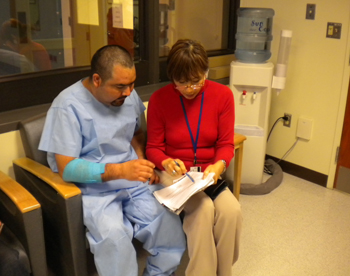 |
Eileen DeSantillana is one of more than 70 language interpreter volunteers who help patients like Jaime Sanchez of Oaxaca, Mexico, navigate the sometimes complicated journey of clinical research.
|
Open an ear in the Clinical Center atrium or a patient waiting room. It’s not uncommon to hear more than one language spoken. America’s research hospital opens its doors to a diverse population of patient volunteers from around the country and outside the US border. Fortunately, the CC also attracts a multi-lingual staff and sits in an area familiar with diversity.
To assure that all patients have a full understanding of their involvement in clinical research, and, conversely, to assure that staff have a full understanding of what the patient is experiencing, the CC relies on a dedicated staff of language interpreters.
“We couldn’t survive without them,” Maria Elena Guzman, program support specialist for the CC Social Work Department Language Interpreters Program (LIP), said of the more than 70 volunteer interpreters.
The LIP also employees three staff members to handle the average of 25 (though as high as 40) interpreter requests that come in a day. From Amharic (spoken in Ethiopia) to Yiddish, the LIP offers interpreters in more than 40 languages. Volunteers come in the form of former and current NIH staff, local retirees of such international entities as the World Bank and the Pan American Health Organization, and medical students or those who wish to soon be such.
“Our volunteers are selfless people who serve with devotion and humanity, said LIP coordinator Brenda Robles. “They value their experience and show respect to the patients. We admire them and highly value them.”
One such valued volunteer is Eileen DeSantillana, a native bilingual Spanish and English speaker. She learned French and Creole during her time spent in Haiti with her Foreign Service Officer husband and interprets all three languages at the CC.
“It is an honor to help the patients here,” said DeSantillana. After four years of dedicated volunteer service, she is moving to California soon.
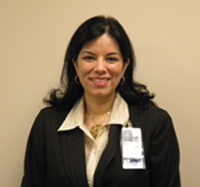 |
Brenda Robles, language interpreter program coordinator, said, “We couldn’t handle all the need if it wasn’t for the volunteers.” The program gets an average of 20 to 25 requests a day, and provided interpreters in more than 40 languages.
|
All volunteers are vetted and tested to assure that their capabilities match the CC needs, particularly knowledge of medical and legal jargon, Robles said. No matter their background, applicants take a written and an oral test then, if they pass, shadow an interpreter to learn the CC process.
A core of steady volunteers commits to one or more days a week where they report to the CC to handle requests, which can span from one procedure to multiple procedures over several days. Other on-call volunteers are available when necessary, often at a few hours or less notice.
Nurse Eleftheria (Libby) Koklanaris of the National Heart, Lung, and Blood Institute Hematology Branch uses the LIP almost daily to interpret for procedure and consents and to communicate and correspond with patients and their doctors in their country of origin.
“Without the Language Interpreter Program and their services it would be challenging to advocate for the patient’s needs, which does not do justice for the patients,” Koklanaris said. “They offer many services and their endless efforts of advocacy and professionalism are what make them desired by many.”
Back to Top
Research Day exposes dietitians to clinical research
The Clinical Center Nutrition Department welcomed 85 attendees from around the country to an NIH Research Day on March 18.
National Cancer Institute/CC Nutrition and Cancer Prevention Research Practicum participants and local dietetic interns heard a morning of presentations from staff before touring the hospital and the Metabolic Clinical Research Unit to get a glimpse of the work of clinical research dietitians
“The reach of research at NIH is so impressive,” said Kelly Morrow, a dietetic intern from Virginia Tech.
Attendees heard a welcome and introduction to the CC from dietetic internship director LCDR Merel Kozlosky, before learning about the role of dietitians in research from Nancy Sebring.
In an acute care hospital, clinical dietitians spend about 80 percent of their time on clinical patient care, with the rest devoted to hospital and department support. Clinical research dietitians, on the other hand, Sebring said, split their time between those responsibilities and research support, though the breakdown varies by staff member.
Sebring presented some types of nutrition-focused research. “For example, in one of our studies looking at obesity we’re interested in patients’ taste preferences—do certain people taste sweet or sour differently than others?” Sebring said.
In a Parade of Protocols series of presentations, CC clinical research dietitians spoke on their roles in various NIH studies. Beth Moylan found it important to evaluate the existing low iodine diet, which is used in conjunction with the treatment for thyroid cancer patients, due to food manufacturing changes and an international patient population consuming foods grown in different soil compositions. LCDR Jennifer Graf explained balancing types of protein for those with methylmalonic acidemia (MMA) who need enough protein for normal anabolic function but not too much of particular amino acids they cannot properly break down. LT Rachel Drabot recounted helping a cancer research patient who experienced a multitude of treatment side effects by providing her with liquid nutrition supplements, individualized nutrition counseling, meal plans, and support.
Dr. Amber Courville, metabolic research dietitian, presented the Metabolic Clinical Research Unit, where more than a dozen obesity-related studies are being carried out, such as one examining how genes and the environment interact to determine body weight. The unit continues to grow and several more protocols with nutrition components are currently under development.
Sarah Johnson, a dietitian and PhD student from Florida, was impressed by the rare conditions NIH dietitians see. “It opened my eyes to things I didn’t already know and hopefully can integrate into my practice,” she said.
Another presentation came from Dr. Amy Subar, nutritionist from the National Cancer Institute, who spoke on new methods of dietary assessment, including using cell phone photos to track what someone eats. Marnie Dobbin, CC clinical research dietitian, presented an overview of botanical and “other” dietary supplements and resources available to guide safe supplement use.
Back to Top
Pharmacist dispenses strategies during Haiti deployment
A clear head during chaos is a valuable trait, as one Clinical Center employee demonstrated during his two-week deployment to Haiti after the January earthquake.
LCDR Fortin Georges of the US Public Health Service and a CC senior staff pharmacist was born in Haiti and lived in Port au Prince, the nation’s capital and one of the areas hardest hit by the natural disaster. He moved to the United States in the early 1990s and joined the NIH in 2006.
“Before the earthquake, I thought Haiti could not get any worse than it was—politically, economically, socially speaking,” Georges said. On January 12 a 7.0 quake made things much worse, leaving hundreds of thousands dead or injured and a million homeless.
“Oh my God, I cannot believe this,” Georges said he thought when he heard of what had happened to his home country. Georges’ mother lives with him in the United States and his father was visiting, so he knew his immediate family was unharmed. He did, though, lose two aunts to the disaster.
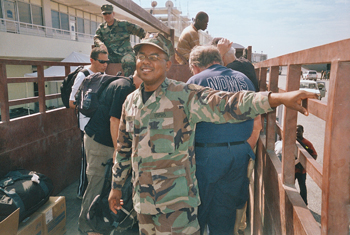 |
|
LCDR Fortin Georges, a CC pharmacist who was born and grew up in Haiti, spent two weeks there after the January earthquake. During his deployment, Georges translated at the US Embassy and helped organize and streamline processes at a medication and supplies warehouse.
|
Georges donated money like many other Americans, but felt that wasn’t enough. Luckily he had a chance to contribute in a much larger way. The day after the quake struck, he was notified he may be deployed as an interpreter. January 19, Georges was on a flight to Haiti, a feat in itself as only military and cargo, no commercial, planes were entering the country.
The scene upon landing was total chaos, Georges said, with multi-national forces milling everywhere, eager to help but without much guidance. The pharmacist made it to the US Embassy where for three days he processed Haitians and US citizens for medical care and transport to the United States.
One patient’s story remained with Georges—a Haitian man who had moved to Georgia but was back visiting his family was out picking up ice cream when the earthquake hit. His wife, children, mother, father, brother, sister-in-law, and nieces and nephews were all crushed by the rubble. “He felt he shouldn’t go back to the US, like he’s abandoning them,” Georges remembered.
The Pan American Health Organization recruited Georges to a warehouse dispensing medications and medical supplies. High demand and disorganization led to long lines and a backlog of 40 to 80 orders a day. With a workforce unfamiliar with the space and a lack of manpower and time to properly process the arriving donations, orders took hours to complete.
Georges called a meeting with the director of the operation to express his concerns and propose a plan. He reached out to a US Army battalion stationed near the warehouse and asked for some men to help inventory the warehouse supplies. Ten to 15 men joined Georges and the other volunteers for three days from 4 pm, when the warehouse closed to requests, to midnight to organize the medications and materials like crutches and gauze pads. Also lending a hand were volunteers from the William J. Clinton Foundation.
Other improvements Georges called for: separate intake and pick up areas to ease the flow of distribution and data entry to account for the supplies arriving and being dispensed.
“It improved the service greatly because the organization was able to know what they had and what they didn’t have. They could find things quicker so we were able to get things out to people faster and catch up with the backlog,” Georges said. “It was exhausting, but I was really happy when we saw where we were getting.”
Georges will see how things have progressed when he returns to Haiti in October on his yearly mission trip with local non-profit Health and Education for Haiti. Read more about his and other CC employees work with the organization in the December 2009 issue of CC News, available online.
Watch a video of Georges talk to HHS from Haiti at http://www.youtube.com/user/USGOVHHS#p/a/1B9054BF0AE74980/7/3y5DB_KkvVA.
Back to Top
What’s age got to do with it?
Office of Workforce Management hosts multi-generational panel
By: Nicole Martino
“Box not!”—a warning when working in a multi-generational workforce.
Office of Workforce Management and Organizational Development (OWMOD) Deputy Chief LCDR Antoinette Jones issued that rule of engagement when discussing dimensions of diversity at the March session of the OWMOD “Exploring Diversity” 2010 brown-bag series.
“The Multigenerational Workforce: What’s age got to do with it?” session on March 17 offered a panel representing a variety of generations as well as a variety of Clinical Center departments.
“With all this talk about different generation traits and values, there will be variation within each,” moderator Jones said, as she cautioned not to put people in boxes.
Jones described the four generations that build the CC’s workforce—traditionalists, baby boomers, generation X, and millennials—sharing common traits and values of each.
On the panel, baby boomers Chauncey Buford, supervisor in the Housekeeping and Fabric Care Department; Dr. Migdalia Rivera-Goba, senior nurse consultant in Nursing and Patient Care Services; and Dr. Patrick Murray, chief of the Microbiology Service in the Department of Laboratory Medicine, offered a veteran perspective. Generation X-er Brian Bourne, institutional program coordinator in the Office of Clinical Research Training and Medical Education, and millennial Maggie McGuire, communications specialist in the Office of Communications, Patient Recruitment, and Public Liaison, represented the younger workforce.
They offered insight on managing and being managed by the different working styles common among the different generations. “I supervise people who often times are much older than I am, and a lot of times they may think that my ideas are too young,” said Buford. “To counter that, I call them all into a meeting and encourage the different age groups to discuss how they feel about the problem.”
The panel and 15 or so staff in attendance also discussed the changing definition of employee retention, especially in regards to members of the millennial generation who tend to switch jobs more than members of older generations, leaving their old coworkers hurt and questioning twenty-somethings’ loyalty.
| Generations’ common characteristics |
|
Traditionalists (age 65 and older): loyal, self-sacrificing, values respect
Baby Boomers (ages 46 to 64): workaholics, optimistic, competitive
Generation-X (ages 30 to 45): independent, skeptical, tech savvy
Millenials (up to age 29): determined, confident, inquisitive
|
Rivera-Goba said she admired the millennials team-work attitude and willingness to do all tasks no matter how big or how small. “My way of acknowledging how they have helped the research team is to provide a lot of different opportunities,” she said.
Even with the differences and difficulties surrounding a multigenerational workforce, the panel acknowledged, there was one thing all agreed on. “Across generations, if we continue to respect one another, it will be reciprocated,” Rivera-Goba said, eliciting a round of nods from her fellow panelists.
The third session in the three-part “Exploring Diversity” OWMOD series will be “Cultural Competence: The Other ‘CC’” on April 21, from noon to 1:00 pm in the Medical Board Room ( 4-2551 in the Hatfield Building). All employees are welcome to attend.
Back to Top
Cracking a smile with some funny friends
Clowns from the Ringling Bros. and Barnum & Bailey Circus visited Clinical Center patients on 1NW like Vienna Mariela Martinez Fuentes and at The Children’s Inn on March 17.
For the thirteenth year, the NIH Recreation and Welfare Association purchased tickets to the show for patients and their families.
This year’s Zing Zang Zoom spectacular featured elephants, tigers, and horses, in addition to the acrobats and illusionists.
Back to Top
Week celebrates volunteers’ offered time and talents
National Volunteer Week runs April 18 to 24.
“Volunteers add a tremendous amount of support to the Clinical Center,” said Courtney Duncan, Volunteer Services coordinator. “They bring excitement, genuine interest, and willingness to learn.”
These generous people contribute approximately 30,000 hours a year to the CC. Patients directly and indirectly benefit as the volunteers assist with tasks that staff would like to do, but often do not have time for, Duncan said.
Below is a sampling of the many ways that CC volunteers contribute to the hospital’s mission and the impact they have on CC staff. To learn about volunteer openings and to apply, visit http://www.cc.nih.gov/volunteers/index.html.
Outpatient clinic volunteers an asset to nurses
I can’t tell you how incredibly valuable the volunteers have been to this clinic. It makes the hospital more user-friendly to our patients.
- –Virginia Warren, clinical research nurse in OP7, where volunteers meet and greet patients and their families and escort them between appointments.
Patient rep volunteers offer, not ask
The Clinical Center patient representative program relies on volunteers to assist patient families in the Department of Anesthesia and Surgical Services waiting room, where they communicate with the operating room staff and escort family members to the recovery room, the Intensive Care Unit, or the cafeteria.
“The volunteer provides comfort to the families and reassurance that someone is there with them to meet their needs,” said patient representative Laura Cearnal (left).
Additionally, these volunteers visit first-time admissions to let them know about the program and to “help to identify issues and concerns that could interfere with the patient’s experience if they are not addressed,” Cearnal said. Coming to the CC can be intimidating and overwhelming, she noted, and patients express appreciation that the volunteer visits for them, not asking anything of them, only offering.
Pharmacy offers chance to learn
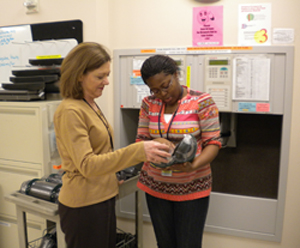 |
Volunteers like Tiffany Murray (right) get experience from their work in the Pharmacy Department, as staff like her supervisor Justine Harris get an extra set of hands.
|
Some volunteers use their contribution as a way to try out an area of interest. Tiffany Murray worked as a pharmacy technician in a retail setting, but wondered if she would prefer work in a hospital setting.
The acute disease states of many Clinical Center patients and the prevalence of intravenous medications makes the experience different. In addition, the investigational drugs and presence of double-blind studies, for example, makes the CC work even more unique.
Murray plans to apply to pharmacy school and is leaning toward to a career in a hospital setting after her two months at the CC. Murray and one other volunteer work under the supervison of licensed pharmacists to help process and dispense medications.
“The census has been very high, so they act as an additional set of helping hands,” said inpatient supervisor and acting Ambulatory Care Pharmacy Section chief Justine Harris, who mentors the volunteers. “It’s rewarding to me, too, to see them going on in their schooling,” she said.
Murray offered some advice to those looking to get the most out of their volunteer opportunity: “Be dependable and committed … Grasp everything! Ask questions!”
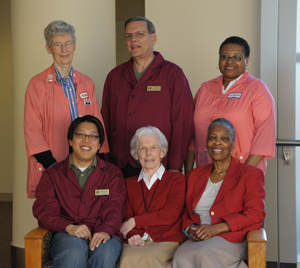 |
|
The CC volunteer squad includes (back, from left) Janet Logan, Victor Canino, Vickie Campbell, and (front, from left) Kristopher Yoon, Louise Gorman, and Jeanette Ferris.
|
Back to Top
CFC recognizes keyworkers at reception
The Clinical Center Combined Federal Campaign (CFC) team hosted a recognition event on March 18 to congratulate the CFC keyworkers for a job well done and to review lessons learned. A slideshow reviewed highlights from the campaign, which kicked off in September. The CC raised more than $190,000 for charity, well over the team’s original goal.
All keyworkers were presented with a certificate noting their commitment, and some shared their successful tactics to engage coworkers. The Radiology and Imaging Sciences keyworker team hosted a chili cook-off to gather staff members, where they also presented on the CFC and answered any questions.
Delisa Nash (fourth from left), a first-time keyworker from Nuclear Medicine, felt her debut was a success. “I generated a lot of positive support within the department this year which is extremely encouraging for next year’s campaign,” she said.
Attending the keyworker recognition from Radiology were (from left) Francine Thomas, Sandra Wilson, Betty Wise, Nash, CFC deputy coordinator Debra Byram, Esther Wolfrey, Bonnie Brynczak, and Tracy Ellis.
Back to Top
CC personnel changes
Fitilis to lead new office
Hillary Fitilis will assume leadership of the Office of Workforce Management and Organizational Development (OWMOD) for the Clinical Center, following the recent departure of Deborah Gardner.
Gardner, former chief of the Office Of Organizational Development, left NIH for a senior advisor position at the Health Resources and Service Administration, in February.
The OWMOD combines the functions of the former Office of Organizational Development with Fitilis’ duties as internal consultant for employee issues, human resources liaison, T42 Clinical Research Support program manager, and point person for a myriad of workforce programs and issues. Fitilis will maintain her current role and responsibilities as deputy chief operating officer for workforce management.
Safra Lodge now under Hospitality
The Edmond J. Safra Family Lodge (Lawrence Eldridge, executive director) will now report to Denise Ford as part of her cluster of responsibilities as Hospitality Services chief.
Interim DASS chief named
Dr. Julia Labovsky will act as interim chief of the Department of Anesthesia and Surgical Services (DASS), following the departure of former Chief Dr. Zena Quezado, who recently left the CC to pursue a research position at the National Children’s Medical Center.
Labovsky has worked in DASS since 2005. While at the CC, she has provided physician oversight for an interdisciplinary group that has supervised the implementation of the new Perioperative Information System to automate nursing and anesthesia documentation.
Back to Top
Laboratorians saluted during professional week
By Gina Mattia
National Medical Laboratory Professionals Week, April 18 to 24, honors the more than 280,000 medical laboratory professionals across the nation who perform and interpret laboratory tests that assist with patient care. Pathologists, other doctoral staff, laboratory technologists, phlebotomists, and technicians at the Clinical Center are among the many heroes of health care who aid in the diagnosis and treatment of our patients.
Using state-of-the-art technology and instrumentation, laboratory professionals help manage disease by playing a role in the diagnosis and treatment of existing conditions through the measurement of various analytes as well as the identification of disease producing microorganisms. Laboratory tests can often identify the presence of disease at an early stage, when the possibility of a cure is greatest.
Despite the important role laboratory professionals play and increasing demands for laboratory services, the profession is experiencing difficulties recruiting personnel. There are several reasons for the laboratory worker shortage, including rising retirement numbers and fewer schools offering medical laboratory technology training.
Medical laboratory professionals can be found in hospitals, doctors’ offices, clinics, research facilities, blood banks, public health centers, the Armed Forces, universities, and industry. The CC will honor its laboratory professionals during the week of April 18 to 24 with a number of staff appreciation events. More information on the Department of Laboratory Medicine can be found at http://www.cc.nih.gov/cp/index.shtml.
Back to Top
HHS ID Badge enrollment and issuance stations open in the CC
Employees, contractors, and affiliates who work in the Clinical Center can now apply for and pick up their new HHS ID Badge—in compliance with Homeland Security Presidential Directive 12 mandating a common identification standard for federal employees and contractors—without leaving the building.
The Division of Personnel Security and Access Control (DPSAC) opened new enrollment and badge issuance facilities in the CC’s south lobby in early February. Individuals receiving e-mail notification to make their enrollment and/or issuance appointment(s) will be given instructions on how to use the DPSAC’s new online scheduling system, and the CC south lobby will be included in the list of locations available to get enrolled and to pick up their new HHS ID Badge.
For more information about the new HHS ID Badge, visit http://idbadge.nih.gov.
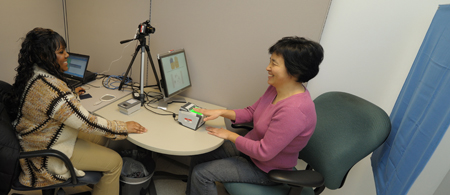 |
Bianca Williams (left) processes about 25 to 30 badge appointments a day. Huiyan Lu of the NIDDK visited the CC South Lobby station in March.
|
Back to Top
Pharmacy facility hosts tour for press
A tour of the new Clinical Center Pharmaceutical Development Section facility attracted members of the international and local press. CC Director Dr. John I. Gallin (below, right, in lab coat) gave opening remarks, and PDS Chief George Grimes and Pharmacy Department Chief Robert DeChristoforo (below, left, in lab coat) led a tour through the new space especially designed for the section.
At right, DeChristoforo showed an example of the possible capsule output by the facility’s new equipment. Machinery with higher production capacity makes the section more efficient.
Learn more about PDS and its new facility in the February issue of CC News, available online.
Back to Top
National Lab Day connects scientists with students
A recent initiative to improve science and math education in the United States, National Lab Day (NLD) is a collaboration between government and more than 200 public- and private-sector organizations. NIH is a sponsor.
A New York-based organization, NLD will promote hands-on learning throughout the year and culminate with special events the first week of May. Volunteer science and technology professionals and educators will work together with students in grades six to 12 to improve America’s science labs and offer inquiry-based experiences in classrooms, learning labs, and after-school programs.
NIH Director Dr. Francis S. Collins called on NIH staff to participate, “I am going to spend some time this April in a Washington, DC, school doing hands-on science and talking about what makes science and discovery so cool to me. I am writing to ask you to do the same.”
Supervisors have discretion to approve appropriate National Lab Day activities as official duties, as they are consistent with NIH’s mission to encourage the next generation of researchers.
Among the other organizations that have pledged support for National Lab Day are the John D. and Catherine T. MacArthur Foundation, the National Science Teachers Association, the National Science Foundation, and the Bill and Melinda Gates Foundation.
Learn about volunteer opportunities, find answers to your questions, and join the many others who have already signed up at http://science.education.nih.gov/ScientistsVolunteer.
Back to Top
Recruiting trials
For more information on any of the following clinical trails or on possible others with a similar focus, call 1-866-444-2214 (TTY: 1-866-411-1010) or visit clinicaltrials.gov and refer to the provided study code.
Food Perception 09-DK-0081
Healthy adults age 18 to 45 at a normal weight are needed for a National Institute of Diabetes and Digestive and Kidney Diseases study looking at the brain’s perception of food through brain imaging. Compensation is provided.
Januvia 09-DK-0055
An NIDDK study will examine the immune function in healthy volunteers age 18 or older given short-term treatment of sitagliptin, a diabetic medicine with the trade name Januvia. Investigators wish to determine if and how sitagliptin alters immune function. All study-related tests are provided at no cost. Compensation is provided.
Epilepsy 01-N-0139
Do you suffer from seizures? Consider participating in a National Institute of Neurological Disorders and Stroke study evaluating and treating people with epilepsy. Individuals will undergo standard diagnostic procedures to determine the type of seizures, their causes, and whether standard drug treatment can help them. All study-related tests are provided at no cost.
Dry Eyes 09-EI-0135
Individuals diagnosed with ocular surface disease, commonly known as dry eye, and who are 18 years or older may be eligible to participate in a study from the National Eye Institute. This study will compare visual function when reading computerized versions of eye questionnaires on the Web and when completing paper versions of eye questionnaires.
Macular Degeneration 08-EI-0103
An NEI study is seeking patients with wet, age-related macular degeneration. Volunteers age 50 years and older can participate in a study exploring the different responses to the drug LUCENTIS®, approved by the Food and Drug Administration.
Back to Top
Upcoming Lectures
CC Grand Rounds
Lipsett Amphitheater, 12 noon
April 7, 2010
Pitfalls and Promise for Individualized Pain Medicine
Hyungsuk Kim, DDS, PhD
Staff Scientist, Pain Research Unit, Symptoms Management Branch, Intramural Research Division, NINR
Symptom Distress Mechanisms in Digestive Disorders
Wendy A. Henderson, CRNP, MSN, PhD
Assistant Clinical Investigator, Biobehavioral Unit, Symptoms Management Branch, Intramural Research Division, NINR
April 14
Contemporary Clinical Medicine: Great Teachers
Mysterious Cases
Mark C. Henderson, MD
Residency Program Director, Department of Internal Medicine; and Associate Dean for Admissions, University of California, Davis, School of Medicine
April 21
From Genes to Targets in Thoracic Malignancies
Giuseppe Giaccone, MD, PhD
Chief, Medical Oncology Branch, NCI
HDAC Inhibitors as Radiation Modifiers: From Bench to Clinic
Kevin A. Camphausen, MD
Chief, Radiation Oncology Branch, NCI
April 28
Updates in Nephrology
Meryl Waldman, MD
Senior Clinical Fellow, Kidney Disease Section, Kidney Disease Branch, NIDDK
Howard A. Austin, III, MD
Staff Clinician, Kidney Disease Section, Kidney Disease Branch, NIDDK
Wednesday Afternoon Lecture Series
Masur Auditorium, 3 pm
April 7, 2010
Genetics after Genome-wide Association Studies: Inflammatory Bowel Disease
Judy Cho, MD
Associate Professor, Medicine and Genetics; and Director, Inflammatory Bowel Disease Center, Yale University
Principal Investigator, Data Coordinating Center; and Chair, Steering Committee, NIDDK Inflammatory Bowel Disease Genetics Consortium
April 14, 2010
Proteins as Chameleons: The Good, the Bad and the Ugly
Catherine Costello, PhD
Professor, Biochemistry, Biophysics and Chemistry, Boston University School of Medicine
Director, Center for Biomedical Mass Spectrometry, Boston University
April 21, 2010
Ancient RNA Relics and Modern Drug Discovery
Ronald Breaker, PhD
Henry Ford II Professor of Molecular, Cellular and Developmental Biology, Yale University
Investigator, Howard Hughes Medical Institute
April 28, 2010
Protecting your Borders: Regulated Entry into the Cell
Sandra Schmid, PhD
Professor and Chair, Department of Cell Biology, Scripps Research Institute
Back to Top
This page last updated on 12/14/2017


 The information on this page is archived and provided for reference purposes only.
The information on this page is archived and provided for reference purposes only.